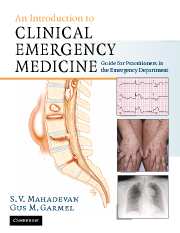Book contents
- Frontmatter
- Contents
- List of contributors
- Foreword
- Acknowledgments
- Dedication
- Section 1 Principles of Emergency Medicine
- Section 2 Primary Complaints
- 9 Abdominal pain
- 10 Abnormal behavior
- 11 Allergic reactions and anaphylactic syndromes
- 12 Altered mental status
- 13 Chest pain
- 14 Constipation
- 15 Crying and irritability
- 16 Diabetes-related emergencies
- 17 Diarrhea
- 18 Dizziness and vertigo
- 19 Ear pain, nosebleed and throat pain (ENT)
- 20 Extremity trauma
- 21 Eye pain, redness and visual loss
- 22 Fever in adults
- 23 Fever in children
- 24 Gastrointestinal bleeding
- 25 Headache
- 26 Hypertensive urgencies and emergencies
- 27 Joint pain
- 28 Low back pain
- 29 Pelvic pain
- 30 Rash
- 31 Scrotal pain
- 32 Seizures
- 33 Shortness of breath in adults
- 34 Shortness of breath in children
- 35 Syncope
- 36 Toxicologic emergencies
- 37 Urinary-related complaints
- 38 Vaginal bleeding
- 39 Vomiting
- 40 Weakness
- Section 3 Unique Issues in Emergency Medicine
- Section 4 Appendices
- Index
31 - Scrotal pain
Published online by Cambridge University Press: 27 October 2009
- Frontmatter
- Contents
- List of contributors
- Foreword
- Acknowledgments
- Dedication
- Section 1 Principles of Emergency Medicine
- Section 2 Primary Complaints
- 9 Abdominal pain
- 10 Abnormal behavior
- 11 Allergic reactions and anaphylactic syndromes
- 12 Altered mental status
- 13 Chest pain
- 14 Constipation
- 15 Crying and irritability
- 16 Diabetes-related emergencies
- 17 Diarrhea
- 18 Dizziness and vertigo
- 19 Ear pain, nosebleed and throat pain (ENT)
- 20 Extremity trauma
- 21 Eye pain, redness and visual loss
- 22 Fever in adults
- 23 Fever in children
- 24 Gastrointestinal bleeding
- 25 Headache
- 26 Hypertensive urgencies and emergencies
- 27 Joint pain
- 28 Low back pain
- 29 Pelvic pain
- 30 Rash
- 31 Scrotal pain
- 32 Seizures
- 33 Shortness of breath in adults
- 34 Shortness of breath in children
- 35 Syncope
- 36 Toxicologic emergencies
- 37 Urinary-related complaints
- 38 Vaginal bleeding
- 39 Vomiting
- 40 Weakness
- Section 3 Unique Issues in Emergency Medicine
- Section 4 Appendices
- Index
Summary
Scope of the problem
One of the most challenging presentations to the emergency department (ED) is a male with acute testicular pain. This complaint causes a high level of patient and health care provider anxiety, owing to the highly sensitive nature of the male genitalia, and the often associated fear of embarrassment on behalf of the patient with problems localized to this region.
Precise diagnosis of acute scrotal problems is not always straightforward; however, differentiating true genitourinary (GU) emergencies requiring prompt evaluation from urgent conditions safe for outpatient management takes precedence over definitive diagnosis. The vast majority of cases of acute testicular pain can be attributed to three diagnostic entities: testicular torsion, epididymitis and appendage torsion. Identification of testicular torsion is of paramount importance as it may threaten testicular viability and future fertility if not managed swiftly and appropriately. Similarly, early identification and aggressive management of necrotizing fasciitis of the perineum (Fournier's disease) is critical.
Anatomic essentials
The male genitalia is composed of the penis (contains the paired erectile bodies and penile urethra), as well as the scrotum (encases the testes, epididymis and vas deferens) (Figure 31.1). There are several fascial planes which collectively comprise the perineum, providing protection and stability to the enclosed structures. However, these anatomic layers may also provide a conduit for the rapid spread of infection in certain cases.
The scrotal wall contains several layers deep to the epidermis, many of which are contiguous with the penis, perirectal region and anterior abdominal wall.
- Type
- Chapter
- Information
- An Introduction to Clinical Emergency MedicineGuide for Practitioners in the Emergency Department, pp. 461 - 472Publisher: Cambridge University PressPrint publication year: 2005
- 1
- Cited by



